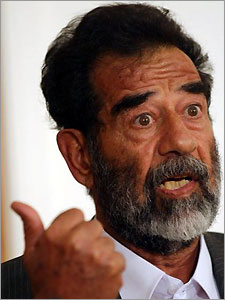The Therapy Sessions
Thursday, June 17, 2004
Interesting Story
Censorship's Trial Balloons:
The censored story was one of World War II's oddest, and it involved a fleet of handmade balloons sent east by the empire of Japan. Improbable though it may sound, from late 1944 through the spring of 1945, the Japanese launched more than 9,000 balloons from their nation's eastern shores. Filled not with mild-mannered hot air but extremely flammable hydrogen and armed with incendiary and antipersonnel bombs, the balloons rode the jet stream across the Pacific Ocean for several days before landing throughout North America.
No, really. Throughout North America. From Alaska to Mexico and as far east as suburban Detroit. Perhaps even more incredible, the balloons themselves were not made of any high-tech, weather-hardened fabric but simple paper panels held together with potato glue.
An extraordinary story, right? Irresistible to any reporter and not just because of the balloons themselves, but because of their potential: If a balloon could carry incendiary bombs across the Pacific, without detection or advance warning, what else might travel aboard? Saboteurs? Biotoxins?
Sure enough, stories began to appear. The day after New Year's, 1945, for example, the New York Herald-Tribune carried a brief story about one of the first balloons to arrive. After that, however, even as the balloons were crash-landing at the rate of two or three per day, the nation's media remained largely mum. That's because on Jan. 4, two days after the Herald-Tribune ran its story, the Office of Censorship asked the nation's print and broadcast journalists to report absolutely nothing more about the balloon bombs. And no one did.
The way the rest of the story plays out proves problematic for foes and supporters alike of wartime censorship. For those who oppose censorship, it's hard to argue against the outcome: Throughout the spring of 1945, the Japanese carefully monitored the American press for mention of their balloons. They found none. And since supply routes and launch sites were getting hammered by an ever-closer American military, Japanese authorities finally decided they could not keep up their unusual campaign absent any evidence of success.
Yet, unbeknownst to them, or virtually anyone outside the U.S. government, the balloons were proving successful. One balloon, for example, managed to cut through power lines leading from the Bonneville Dam on the Columbia River. A resulting power outage that was quickly restored may sound insignificant; however, that particular dam provided power to a factory in Hanford, Wash., which was secretly manufacturing plutonium for use in the atomic bombs destined for Japan. When the power went out, the plant's emergency safeguards—which had never been tested—were suddenly called upon to prevent the reactor from melting down. Plant officials held their breath; everything worked as it was supposed to (though it took three days to resume full operations).
In the end, America's best defense may have been the weather. Designed to start fires—which would deplete natural resources and divert human ones—the balloons plummeted into the Pacific Northwest during its wettest months.
On May 22, 1945, the government suddenly changed its mind about the ban on press coverage. The War and Navy departments issued a joint statement announcing, in part, "It is the view of the departments that the possible saving of even one American life through precautionary measures would more than offset any military gain accruing to the enemy from the mere knowledge that some of his balloons actually have arrived on this side of the Pacific."
This sounds reasonable and prudent, if a bit tardy. But there's a reason the departments suddenly came around to this way of thinking, and this is where the balloon campaign becomes a troubling case study for censorship's supporters.
Seventeen days earlier, on May 5, the Rev. Archie Mitchell and his pregnant wife, Elsie, took a group of children from his church on an outing to Oregon's Gearhart Mountain. Mitchell let the kids out of the car before he went off to park. His wife got out, too, to supervise. Mitchell found a spot up the road and pulled over. As he was getting out, he saw his charges clustered around a large white object on the forest floor. One of the kids tugged at it.
The bomb exploded, killing all the children and Mrs. Mitchell. They were the only fatalities on the U.S. mainland due to enemy action during World War II, and though a marker remembers them on Gearhart Mountain today, they're mostly overlooked, as they were by the War and Navy departments in that May 22 statement, which made no mention of the fatalities, only that "Japanese free balloons are known to have landed or dropped explosives in isolated localities. No property damage has resulted.
From Burton Terrace.


